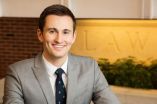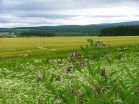(Press-News.org) Quantum information can't break the cosmic speed limit, according to researchers* from the National Institute of Standards and Technology (NIST) and the University of Maryland's Joint Quantum Institute. The scientists have shown how attempts to "push" part of a light beam past the speed of light results in the loss of the quantum data the light carries. The results could clarify how noise might limit the transfer of information in quantum computers.
The speed of light in vacuum is often thought to be the ultimate speed limit, something Einstein showed to be an unbreakable law. But two years ago,** members of the research team found a sort of "loophole" in the law when they devised a new way to push part of the leading edge of a pulse of light a few nanoseconds faster than it would travel normally. While the 'pulse front' (the initial part of the pulse) still traveled at the usual constant speed, the rising edge and the pulse peak could be nudged forward a bit. Since waves carry information, the team decided to explore what their previous results might mean for quantum information.
"How does the beam's quantum information behave if you try to speed up the leading edge?" says NIST's Ryan Glasser. "We knew if you could speed the information up successfully, it would give rise to all kinds of causality problems, as you see in science fiction movies about people traveling back in time. So while no one expects it to be possible, just what prevents it from happening? That's what we wanted to know."
The team set up a new experiment that "entangled" the photons in two different light beams, which means that quantum information in one beam—such as amplitude—is strongly correlated to information in the other. Ordinarily, measuring these parameters in one beam can reveal those in the second. But when the team nudged the waves in one beam forward and took their measurements, they found the correspondence with the second beam started to taper off, and the more they pushed, the more degraded with noise the signal became.
"We sped up the peak of the correlation between the two beams," Glasser says, "but we couldn't push the quantum information any faster than the speed of light in vacuum."
While further work is needed to determine what is fundamentally enforcing this information speed limit, the current findings could be useful for understanding information transfer within quantum systems such as those that will be needed within quantum computers. "We speculate that quantum noise and distortion set that limit," Glasser says.
INFORMATION:
A more detailed explanation of the study is available at http://jqi.umd.edu/news/advanced-light
* J.B. Clark, R.T. Glasser, Q. Glorieux, U. Vogl, T. Li, K.M. Jones and P.D. Lett. Quantum mutual information of an entangled state propagating through a fast-light medium. Nature Photonics. Published online May 25, 2014. DOI: 10.1038/nphoton.2014.112,
** See the May 2012 Tech Beat story, "First Light: NIST Researchers Develop New Way to Generate Superluminal Pulses" at http://www.nist.gov/public_affairs/tech-beat/tb20120502.cfm#light.
Rush a light wave and you'll break its data, say NIST scientists
2014-05-30
ELSE PRESS RELEASES FROM THIS DATE:
Study suggests strong link between depression and early death among seniors with diabetes
2014-05-30
People with diabetes have about double the risk of premature death as people of the same age without diabetes. Studies also have shown that they have about twice the odds of suffering from depression, which further increases their mortality risk.
A new UCLA-led study published in the Journal of the American Geriatrics Society found that among adults 65 and older with diabetes, depression is linked with a far greater chance for early death compared with people of the same age who do not have depression.
The researchers suggest that the higher mortality rate among those ...
Hero or sissy? Study explores perception of injured athletes
2014-05-30
NFL teams shoulder most of the blame for players' injuries and sports journalists can shift football cultural norms toward valuing players who put their health first.
These are the key findings of a new study authored by Clemson University researchers Jimmy Sanderson and Melinda Weathers that examined health and safety issues in sports. It was published in the journal Communication & Sport.
"Media coverage of players who decide to sit out or play through an injury may impact players' future decision-making as well as fans' attitudes towards these players," said Sanderson.
"Sitting ...
Australia's deadly eruptions the reason for the first mass extinction
2014-05-30
A Curtin University researcher has shown that ancient volcanic eruptions in Australia 510 million years ago significantly affected the climate, causing the first known mass extinction in the history of complex life.
Published in prestigious journal Geology, Curtin's Associate Professor Fred Jourdan, along with colleagues from several Australian and international institutions, used radioactive dating techniques to precisely measure the age of the eruptions of the Kalkarindji volcanic province.
Dr Jourdan and his team were able to prove the volcanic province occurred ...
X-ray pulses on demand from electron storage rings
2014-05-30
Everything we know nowadays about novel materials and the underlying processes in them we also know thanks to studies at contemporary synchrotron facilities like BESSY II. Here, relativistic electrons in a storage ring are employed to generate very brilliant and partly coherent light pulses from the THz to the X-ray regime in undulators and other devices. However, most of the techniques used at synchrotrons are very "photon hungry" and demand brighter and brighter light pulses to conduct innovative experiments. The general greed for stronger light pulses does, however, ...
Glow-in-the-dark tool lets scientists find diseased bats
2014-05-29
Scientists working to understand the devastating bat disease known as white-nose syndrome (WNS) now have a new, non-lethal tool to identify bats with WNS lesions —ultraviolet, or UV, light.
If long-wave UV light is directed at the wings of bats with white-nose syndrome, it produces a distinctive orange-yellow fluorescence. This orange-yellow glow corresponds directly with microscopic skin lesions that are the current "gold standard" for diagnosing white-nose syndrome in bats.
"When we first saw this fluorescence of a bat wing in a cave, we knew we were on to something," ...
Police reform law underenforced by Department of Justice
2014-05-29
CHAMPAIGN, Ill. — A law designed to combat police misconduct is hamstrung by limited resources, a lack of transparency and "political spillover" at the U.S. Department of Justice, says a recently published empirical study by Stephen Rushin, a law professor at the University of Illinois and expert in criminal law and policing.
In 1994, Congress passed 42 U.S.C. Section 14141 as part of the Violent Crime Control and Law Enforcement Act, granting the U.S. attorney general the power to initiate structural reform litigation against local police departments engaged in a pattern ...
Powerful tool combs family genomes to find shared variations causing disease
2014-05-29
(SALT LAKE CITY)—Scientists at the University of Utah (U of U), the University of Texas MD Anderson Cancer Center in Houston and colleagues have developed a powerful tool called pVAAST that combines linkage analysis with case control association to help researchers and clinicians identify disease-causing mutations in families faster and more precisely than ever before.
In a study in Nature Biotechnology, the researchers describe cases in which pVAAST (the pedigree Variant Annotation, Analysis and Search Tool) identified mutations in two families with separate diseases ...
Ecosystem services: Looking forward to mid-century
2014-05-29
(Santa Barbara, Calif.) — As population grows, society needs more — more energy, more food, more paper, more housing, more of nearly everything. Meeting those needs can lead to changes in how land is used.
Native grasslands, forests and wetlands may be converted into croplands, tree plantations, residential areas and commercial developments. Those conversions can, in turn, diminish the health of natural ecosystems and their ability to provide an array of valuable services, such as clean air and water, wildlife and opportunities for recreation, to name a few.
In two ...
Study: Baltimore hookah bars contain elevated levels of carbon monoxide and air nicotine
2014-05-29
Smoking waterpipes, or hookahs, creates hazardous concentrations of indoor air pollution and poses increased risk from diminished air quality for both employees and patrons of waterpipe bars, according to a new study from the Institute for Global Tobacco Control at the Johns Hopkins Bloomberg School of Public Health. In an analysis of air quality in seven Baltimore waterpipe bars, researchers found that airborne particulate matter and carbon monoxide exceeded concentrations previously measured in public places that allowed cigarette smoking and that air nicotine was markedly ...
Solar panel manufacturing is greener in Europe than China, study says
2014-05-29
Solar panels made in China have a higher overall carbon footprint and are likely to use substantially more energy during manufacturing than those made in Europe, said a new study from Northwestern University and the U.S. Department of Energy's Argonne National Laboratory. The report compared energy and greenhouse gas emissions that go into the manufacturing process of solar panels in Europe and China.
"We estimated that a solar panel's carbon footprint is about twice as high when made in China and used in Europe, compared to those locally made and used in Europe," said ...





